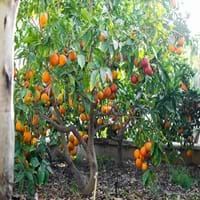Life Span
Perennial
Perennial
Origin
Hybrid origin
Southeastern Asia, China
Types
Aristocrat, Buckeye Belle, Henry Bockstoce , Abalone Pearl, Coral Supreme, Cytherea, Charlie's White
Tarocco, Sanguinello,
Moro
Number of Varieties
Not Available
Habitat
Hillside, Woods
Sunny Edge, Woodland Garden
USDA Hardiness Zone
Not Available
9-11
Sunset Zone
Not Available
H1, H2, 8, 9, 12, 13, 14, 15, 16, 17, 18, 19, 20, 21, 22, 23, 24
Habit
Clump-Forming
Oval or Rounded
Flower Color
Not Available
White
Flower Color Modifier
Bicolor
Bicolor
Fruit Color
Not Available
Orange, Orange Red
Leaf Color in Spring
Not Available
Dark Green
Leaf Color in Summer
Not Available
Dark Green
Leaf Color in Fall
Not Available
Dark Green
Leaf Color in Winter
Light Green
Light Green
Leaf Shape
Compound
Ovate
Plant Season
Spring, Summer
Spring, Summer, Fall, Winter
Sunlight
Full Sun, Partial Sun, Partial shade
Full Sun
Type of Soil
Clay, Loam
Loam
The pH of Soil
Acidic, Neutral, Alkaline
Acidic, Neutral
Soil Drainage
Average
Well drained
Bloom Time
Not Available
Spring, Late Winter, Indeterminate
Tolerances
Drought
Drought
Where to Plant?
Ground, Pot
Ground
How to Plant?
Grafting, Seedlings, Stem Planting, Transplanting
Seedlings, Semi-ripe cuttings
Plant Maintenance
Medium
Medium
Watering Requirements
Does not require lot of watering, It cannot sustain wet-feet, Keep the ground moist but not water-logged, Needs watering once a week, Prefer drip-irrigation instead of Over-head watering, Water occasionally
Do Not over Water, Keep the ground moist but not water-logged, Needs watering once a week
In Summer
Lots of watering
Lots of watering
In Spring
Moderate
Moderate
In Winter
Average Water
Average Water
Soil pH
Acidic, Neutral, Alkaline
Acidic, Neutral
Soil Type
Clay, Loam
Loam
Soil Drainage Capacity
Average
Well drained
Sun Exposure
Full Sun, Partial Sun, Partial shade
Full Sun
Pruning
Do not prune during shooting season, Prune to control growth, Remove dead or diseased plant parts, Remove deadheads
Pinch Tips, Remove branches, Remove damaged fruit, Remove damaged leaves, Remove dead branches, Remove dead leaves
Fertilizers
All-Purpose Liquid Fertilizer
All-Purpose Liquid Fertilizer, organic fertlizers
Pests and Diseases
Botrytis Blight, Leaf spot, Stem spot, Viruses
Red blotch
Plant Tolerance
Drought
Drought
Flower Petal Number
Not Available
Single
Foliage Texture
Not Available
Medium
Foliage Sheen
Not Available
Glossy
Attracts
Ants
Birds, Butterflies
Allergy
Not Available
Pollen
Aesthetic Uses
Beautification, Bouquets, Showy Purposes, Used for decorating walls, fences, gates, hedges, etc.
Not Used For Aesthetic Purpose
Beauty Benefits
Not Available
Good for skin
Environmental Uses
Air purification
Air purification, Indoor Air Purification
Medicinal Uses
Cough, Gout, Headache, Heartburn, Kidney problems, Upset stomach, Urinary tract problems
Appetizer, Blood purifier, Carminative, Miscellany, Tonic
Part of Plant Used
Flowers, Root, Seeds
Flowers, Fruits
Other Uses
Showy Purposes, Used as Ornamental plant, Used for fragrance
Used as essential oil
Used As Indoor Plant
No
Yes
Used As Outdoor Plant
Yes
Yes
Garden Design
Cutflower, Feature Plant, Foundation, Mixed Border
Container, Edible, Feature Plant, Fruit / Fruit Tree, Hedges, Mixed Border, Screening / Wind Break, Topiary / Bonsai / Espalier, Tropical
Botanical Name
PAEONIA 'Rachel'
CITRUS sinensis
Common Name
Intersectional Peony
Blood Orange, Naval Orange, Orange, Sweet Orange
In Hindi
Intersectional Peony
Blood Orange Tree
In German
Intersectional Pfingstrose
Blut- Orange Tree
In French
intersectionnelle Pivoine
Sang Orange Tree
In Spanish
interseccional Peony
Árbol de la naranja de sangre
In Greek
διατομεακές Παιώνια
Blood Orange Tree
In Portuguese
interseccional Peony
Orange Tree sangue
In Polish
międzysegmentowe Piwonia
Krew Orange Tree
In Latin
Intersectional AGLAOPHOTIS
Sanguinem Aliquam ligno
Phylum
Tracheophyta
Magnoliophyta
Class
Magnoliopsida
Magnoliopsida
Order
Saxifragales
Sapindales
Family
Paeoniaceae
Rutaceae
Clade
Angiosperms, Core eudicots, Eudicots
Angiosperms, Eudicots, Rosids
Tribe
Not Available
Citreae
Subfamily
Not Available
Aurantioideae
Number of Species
Not Available
Season and Care of Intersectional Peony and Blood Orange
Season and care of Intersectional Peony and Blood Orange is important to know. While considering everything about Intersectional Peony and Blood Orange Care, growing season is an essential factor. Intersectional Peony season is Spring and Summer and Blood Orange season is Spring and Summer. The type of soil for Intersectional Peony is Clay, Loam and for Blood Orange is Loam while the PH of soil for Intersectional Peony is Acidic, Neutral, Alkaline and for Blood Orange is Acidic, Neutral.
Intersectional Peony and Blood Orange Physical Information
Intersectional Peony and Blood Orange physical information is very important for comparison. Intersectional Peony height is 71.10 cm and width 60.00 cm whereas Blood Orange height is 457.20 cm and width 365.76 cm. The color specification of Intersectional Peony and Blood Orange are as follows:
Intersectional Peony flower color: Not Available
Intersectional Peony leaf color: Not Available
Blood Orange flower color: White
- Blood Orange leaf color: Dark Green
Care of Intersectional Peony and Blood Orange
Care of Intersectional Peony and Blood Orange include pruning, fertilizers, watering etc. Intersectional Peony pruning is done Do not prune during shooting season, Prune to control growth, Remove dead or diseased plant parts and Remove deadheads and Blood Orange pruning is done Pinch Tips, Remove branches, Remove damaged fruit, Remove damaged leaves, Remove dead branches and Remove dead leaves. In summer Intersectional Peony needs Lots of watering and in winter, it needs Average Water. Whereas, in summer Blood Orange needs Lots of watering and in winter, it needs Average Water.





